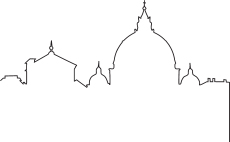
Chapter Twenty
Return of the Apostle
Ferrua’s triumph appeared complete and permanent. Anyone else with direct knowledge of the excavations — Popes Pius XII and Paul VI, Carroll, McGeough, Kaas, Strake, and Correnti — had died. Only Ferrua remained, and he held the highest position on matters relating to Vatican antiquities. Despite scientific evidence, Guarducci’s persistent and eloquent defense of her finds, and Paul VI’s endorsement, the Graffiti Wall bones remained in storage in a papal chapel. The bones went unmentioned by the Vatican guides.
Pope John Paul II was the first non-Italian pope in four centuries. Unlike Pius XII and Paul VI, he was not a Vatican insider. Deeply preoccupied with the struggles of Communism in the East and secularism in the West, he did not share the keen interest of Pius XII and Paul VI in archeology. While John Paul was a deeply inspirational figure for the world and clearly a man for the ages, there is no evidence that the history or working of the Vatican structures themselves held much interest for him. As head of Vatican antiquities, Ferrua held all the cards, and there were not even any other players left at the table. It appeared that the Graffiti Wall bones would once again be wholly forgotten.
In 2003, Ferrua died and was buried at his request and as an honor in the Necropolis below the Vatican, close to where his excavations began sixty-three years earlier. Ferrua and Ludwig Kaas are believed to be the only priests resting in the Necropolis, surrounded by many popes and royal persons, as well as the remains of many hundred ancient Romans. Ferrua was honored by numerous articles, particularly from the secular press, as a hero who prevented the Church from laughably presenting the bones of mice and animals as relics of Saint Peter. Further articles challenged the existence of Peter or expressed doubt that he had ever come to Rome at all. At the time of Ferrua’s death, several articles once again viciously ridiculed Guarducci and her find.
Over time, following Ferrua’s death, Vatican publications, which had previously ignored Guarducci’s great work and failed to mention her at all, began to include mentions of her work, describing it as controversial. It was a definite, although limited promotion from nonperson.220
June 2009
With the election of Pope Benedict XVI came a resurgence of serious study of the origin of the gravesites of Peter and Paul, both of whom were executed in Rome by Nero. On June 28, 2009, Pope Benedict confirmed that the gravesite of Paul on the Port Road to Ostia (the place of his beheading) outside the walls of Rome was authentic. Carbon dating of the bones in Paul’s tomb proved they were from the first century, confirming them as Paul’s authentic remains.221 Peter’s turn would come next.
March 2013
Although both Ferrua and Guarducci were gone, they each continued to have passionately committed advocates. In March 2013, following the retirement of Benedict XVI, Cardinal Jorge Bergoglio was elected pope, taking the name Francis. Within a short time after his election, Francis knelt and prayed in the Necropolis at the location of Peter’s purported grave at the Graffiti Wall. He then continued a detailed review of all the evidence gathered by Ferrua, Guarducci, Correnti, and retained experts — much of that evidence fifty years old or even older. The review apparently had been initiated by his predecessor, Benedict. After this review, at a papal Mass in Vatican Square on November 24, 2013, marking the end of the Year of Faith, Pope Francis displayed the Graffiti Wall bones. Clutching them to himself in a case, he announced to the large crowd and the world that these were indeed Peter’s relics.222 A few days later, on December 5, 2013, Pope Francis in a public ceremony returned the bones to public display in the niche in the Graffiti Wall where they had been found more than seventy years before. He once again placed the full weight of the Catholic Church behind their authenticity as Peter’s relics. He became the third pope to affirm Peter’s burial on Vatican Hill, and thus, in essence, Peter’s presence and martyrdom in Rome.
The bones remain today on public display in the Graffiti Wall under the Vatican, accessible through a public entrance off Vatican Square. In the view of the Church, the Apostle’s relics have returned home to their proper place near the site where the Apostle gave up his life for his belief in Christ.